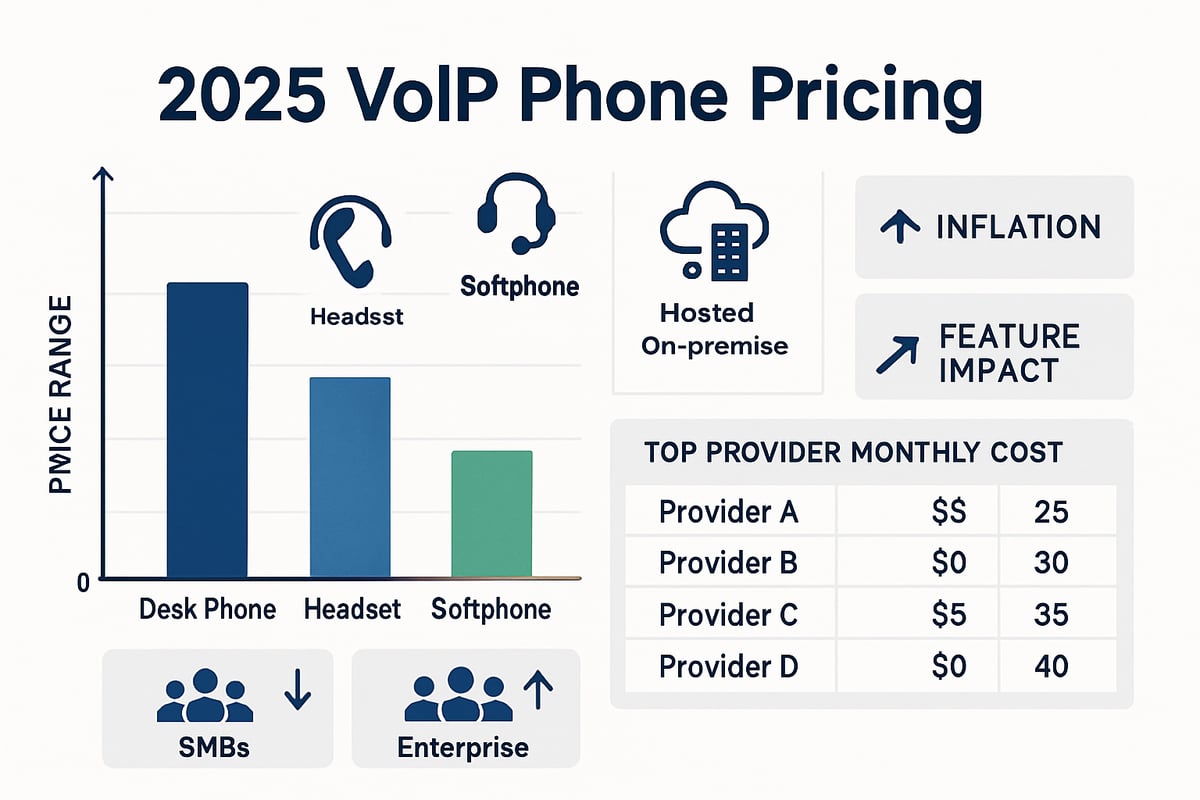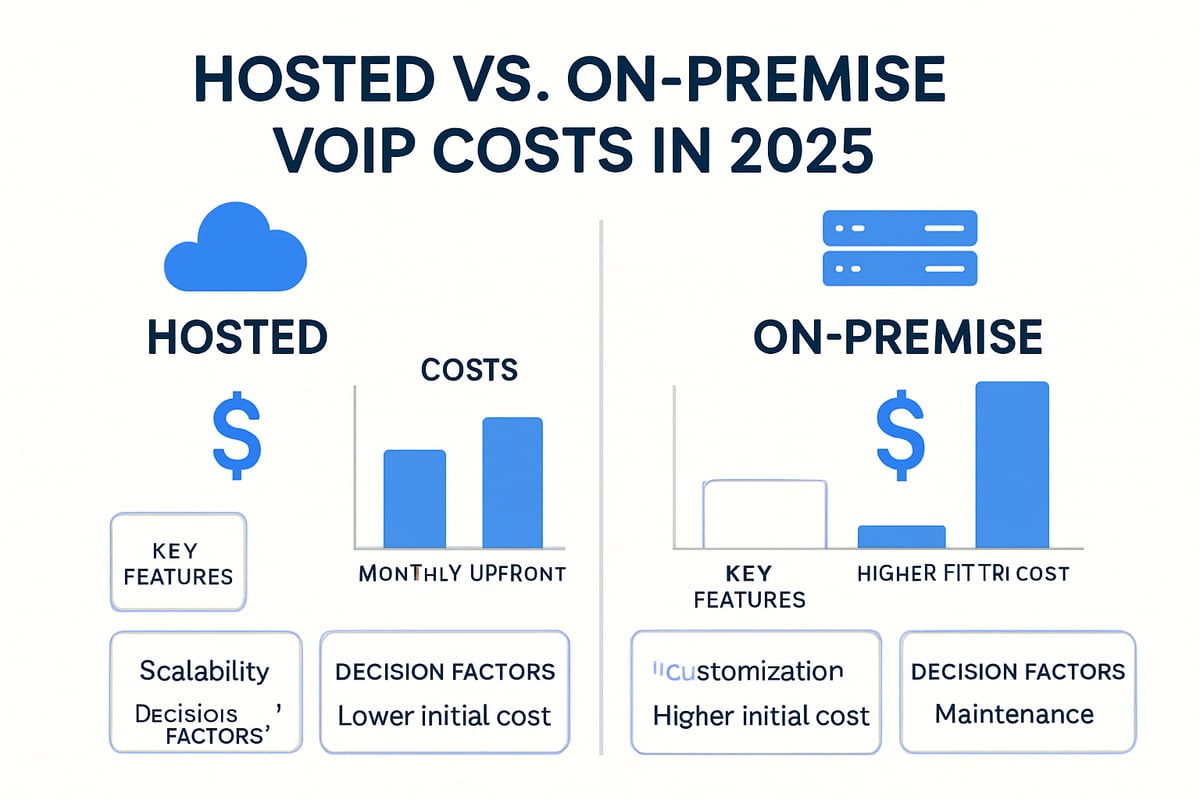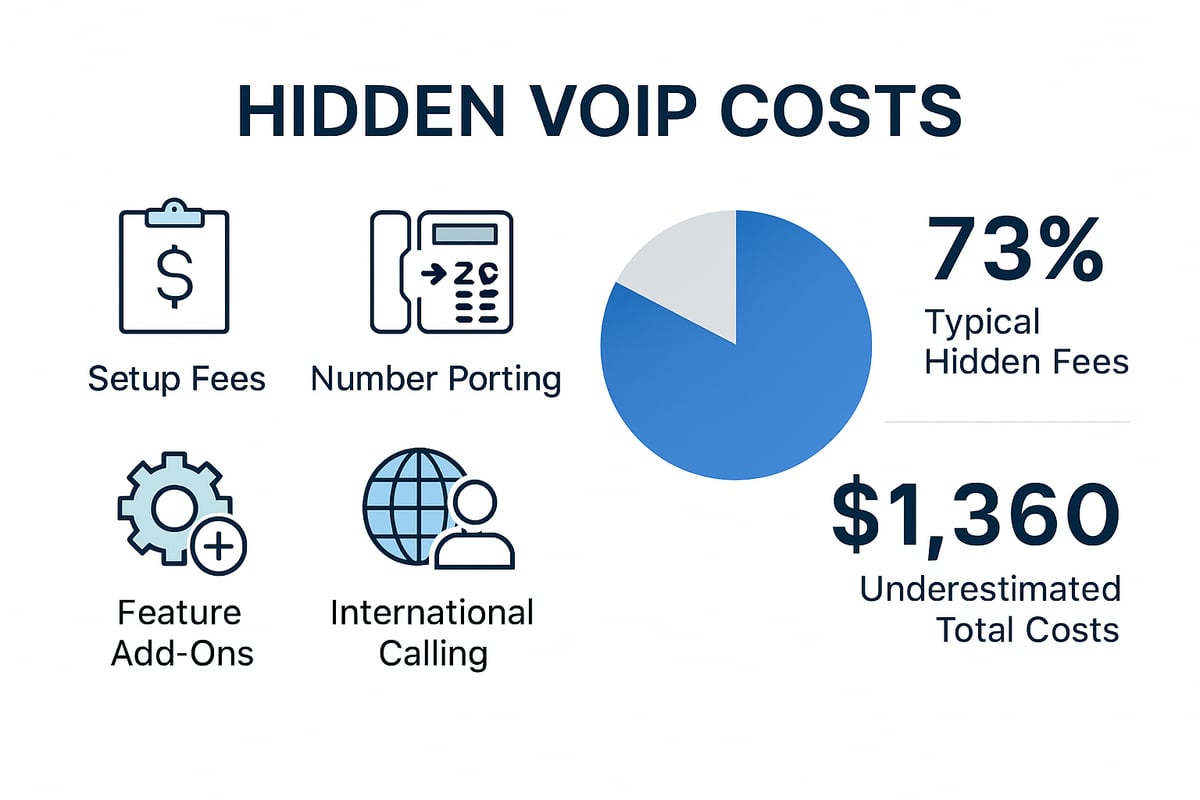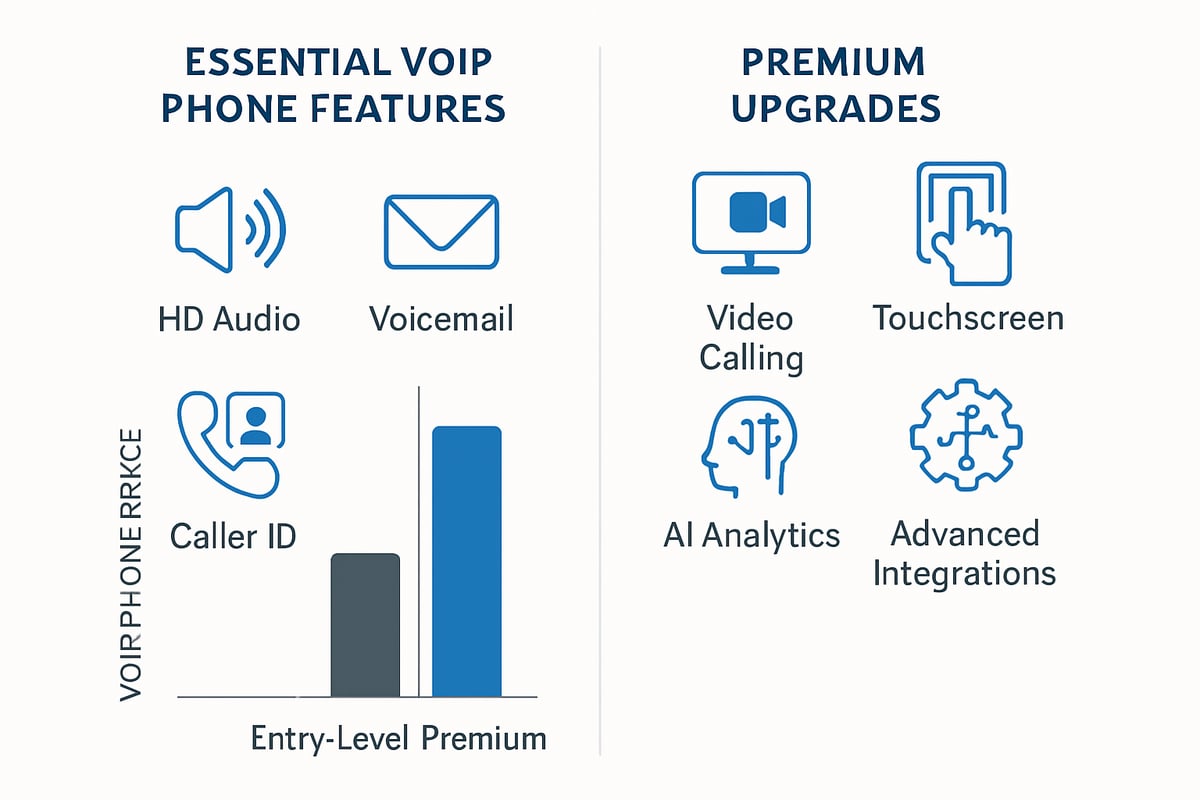VoIP Phone Price Guide 2025: Smart Buying Insights
Discover the 2025 VoIP phone price landscape. Compare costs, top providers, and smart buying tips to save money and choose the best VoIP solution for your needs.
Redaction
22/09/2025, 12:30:00VoIP phone prices are rapidly evolving. Are you ready to make a smart investment in 2025? As businesses and individuals seek more cost-effective ways to connect, understanding the voip phone price landscape is essential for staying competitive.
This guide provides a comprehensive overview of 2025 pricing trends, including current rates, what impacts costs, hosted versus on-premise solutions, hidden fees, and top providers. You will also discover actionable strategies for making the right purchase.
Unlock the potential for significant savings and better ROI. Let this guide equip you to make informed, confident decisions about your next VoIP solution.
VoIP Phone Pricing in 2025: What to Expect
The landscape of voip phone price is changing quickly as 2025 approaches. New technologies, shifting demand, and global trends are shaping what businesses and individuals can expect to pay. Understanding these changes is crucial for making smart, cost-effective decisions when investing in VoIP solutions.

Key Pricing Trends and Market Overview
The VoIP industry in 2025 is projected to continue its rapid expansion, fueled by global digital transformation and hybrid work models. As businesses seek flexible, scalable communication, the voip phone price spectrum is evolving to reflect both affordability and advanced features.
Average hardware prices set the baseline for most buyers:
| Device Type | Price Range |
|---|---|
| Desk Phones | $50-$350 |
| Headsets | $15-$350 |
| Softphones (App) | Free-$50 |
Hosted VoIP solutions remain dominant, offering monthly subscriptions between $10 and $30 per user. In contrast, on-premise systems typically require an upfront investment exceeding $10,000 for hardware and setup, making them less accessible for small businesses.
Market leaders continue to shape expectations:
- Zoom Phone: $15/user/month
- RingCentral: $20/user/month
- Vonage: $13.99/user/month
Inflation and supply chain volatility can push prices higher, especially for physical devices. Enhanced features - like HD audio, video support, or wireless connectivity - also influence voip phone price. For SMBs, hosted VoIP is still the most affordable choice due to minimal upfront costs and easy scalability, while large enterprises may negotiate volume discounts but face greater complexity.
For a deeper dive into these market shifts and adoption statistics, see the VoIP market size and adoption statistics.
Factors Influencing VoIP Phone Prices
A variety of elements contribute to the overall voip phone price. First, hardware features play a significant role: HD audio, touchscreen displays, and wireless options can push costs toward the higher end. Brands like Yealink, Cisco, and Polycom often command premium pricing due to reliability and reputation.
The number of users or extensions directly affects overall expenses, as most providers use a per-user pricing model. Contract length and bundled service packages can unlock lower rates, while short-term agreements may cost more per month.
Location matters as well. Regional pricing differences reflect local taxes, import fees, and market demand. Integration capabilities with CRM systems and business tools are increasingly important, sometimes requiring additional licensing fees.
For example, an advanced desk phone with integrated video calling and wireless support may cost over $350 per unit, while a basic model could be under $80. Businesses should carefully analyze their needs to avoid unnecessary spending and optimize their voip phone price investment.
Hosted vs. On-Premise VoIP: Cost Comparison
Choosing between hosted and on-premise VoIP solutions is a pivotal decision for any organization. Understanding the voip phone price differences, benefits, and long-term impacts helps you make the right investment for your communication needs.

Hosted VoIP: Pricing Structure and Benefits
Hosted VoIP operates on a monthly subscription model, typically ranging from $10 to $30 per user each month. This structure eliminates the need for significant upfront investment in PBX hardware or complex infrastructure, making the voip phone price more manageable for businesses of all sizes.
Providers such as Ooma and GoTo Connect offer transparent pricing, minimal setup fees, and a suite of included features. These often cover toll-free numbers, mobile app access, and cloud-based management. Hosted solutions are highly scalable, letting you add or remove users as your needs change without disrupting operations.
For small and medium businesses, hosted VoIP reduces financial risk and allows for predictable budgeting. The flexibility to support remote teams, paired with robust support, makes it a favored choice when evaluating voip phone price options. In many cases, companies have reduced upfront costs and ongoing maintenance by switching to hosted solutions.
On-Premise VoIP: Upfront and Ongoing Costs
On-premise VoIP requires purchasing and installing PBX hardware, local servers, and compatible phones. The initial voip phone price for a 20-user setup can reach $14,500 before a single call is made. This includes hardware ($6,500), desk phones ($3,000), setup ($1,000), and software licenses ($4,000).
Ongoing costs are another consideration. Businesses must budget for IT staff, software updates, and maintenance, which can add up quickly. While on-premise systems offer greater control and customization, the voip phone price reflects the increased complexity and risk.
Larger enterprises with dedicated IT teams may benefit from the additional control and security. However, for most organizations, the high entry cost and ongoing management burden make on-premise VoIP less appealing compared to more flexible, cloud-based options.
Cost Comparison Table and Decision Factors
To help visualize the differences, consider the following comparison table:
| Feature | Hosted VoIP | On-Premise VoIP |
|---|---|---|
| Cost per user/month | $10-$30 | N/A |
| Upfront hardware | Minimal | $10,000+ |
| Maintenance | Included in fee | Extra IT costs |
| Scalability | High, easy to adjust | Limited, complex changes |
| Support | Vendor managed | In-house required |
Key decision factors include budget, IT expertise, business size, and the need for direct system control. Data indicates that the majority of SMBs choose hosted solutions for their lower voip phone price and ease of management. For more insights on market trends, see this VoIP services market size and trends report.
No matter your choice, understanding the full voip phone price picture ensures your investment aligns with your operational goals and growth plans.
Hidden Costs and Fees: What Buyers Need to Know
Hidden costs can significantly impact your total voip phone price, catching many buyers off guard. Understanding these extra expenses is essential for staying within budget and making informed decisions.

Common Hidden Fees in VoIP Phone Purchases
Many organizations focus on the upfront voip phone price, but hidden fees often drive up the true cost. Here are the most common charges buyers encounter:
- Setup and Installation: Providers may charge per extension, with fees like $50 for each new line configured.
- Number Porting Fees: Moving your existing numbers can incur one-time costs, often overlooked in the initial quote.
- Toll-Free Numbers: While some plans include toll-free minutes, exceeding the limit leads to overage charges.
- Feature Add-Ons: Premium features such as voicemail transcription, call recording, and analytics typically require additional monthly payments.
- Hardware Leasing vs. Purchasing: Leasing phones or headsets might seem cost-effective but adds recurring expenses to your voip phone price.
- International Calling and Premium Support: Calls outside your region and priority support can escalate monthly bills quickly.
- Software Licensing and Upgrades: On-premise systems require periodic software updates and licenses, which can be costly.
For example, a business might receive a set number of toll-free minutes, but overages can double the expected voip phone price. Reviewing all potential fees upfront is vital to avoid budget surprises.
How to Identify and Avoid Extra Costs
Navigating the true voip phone price requires diligence and a proactive approach. Begin by carefully reviewing all contracts and service agreements. Providers may bundle hidden fees in fine print, so request a detailed breakdown of every possible charge.
Compare "all-in" pricing plans against base prices with add-ons to assess which offers better long-term value. Negotiating for bundled packages or volume discounts can help minimize overall expenses. Many businesses benefit from utilizing free trials or demos, allowing them to evaluate whether a solution justifies its voip phone price.
Leverage industry resources, such as the VoIP industry insights blog, to stay updated on typical cost structures and hidden fee trends. Remember, companies often underestimate their total cost by 15 to 20 percent due to overlooked fees. By taking these steps, you can make smarter purchasing decisions and secure a solution that fits your needs without financial surprises.
Essential Features vs. Premium Upgrades: What Drives Price?
Understanding what you get for your investment is critical when evaluating voip phone price in 2025. The distinction between essential features and premium upgrades can significantly impact your bottom line. Knowing which features deliver the most value ensures you avoid unnecessary spending and maximize your communications ROI.

Standard Features Included in Most VoIP Phones
Most modern VoIP phones come packed with a robust set of standard features that meet the needs of many businesses. These typically include HD voice for crystal-clear calls, reliable call forwarding, voicemail, caller ID, and conference calling. Mobile app access and compatibility with softphone software are also commonplace, supporting flexible work environments.
Security is a foundational element, with encryption and basic compliance built in by default. These core capabilities address the majority of daily communication requirements for small and mid-sized companies.
Entry-level desk phones generally fall within the $50 to $80 range. This price point gives you access to all the essential features needed for professional connectivity. For many organizations, sticking to standard features is the most cost-effective way to manage voip phone price while still supporting productivity and collaboration.
Premium Upgrades That Increase Cost
Premium features can dramatically increase the voip phone price, especially as technology evolves. Upgrades like video calling, touchscreen displays, and wireless connectivity (Bluetooth or Wi-Fi) are now available on high-end models. Advanced integrations, such as CRM connectivity, analytics dashboards, and even AI-powered tools, push costs higher but may deliver strategic advantages.
Some phones offer multi-line support, receptionist consoles, and enhanced call queuing, catering to call centers or enterprise needs. Security upgrades, including advanced encryption and regulatory compliance, are also available at a premium.
For example, a high-end desk phone with video capabilities, wireless support, and smart integrations can easily exceed $350 per unit. As feature sets expand, staying informed about future VoIP trends and AI integration can help you anticipate which upgrades may become must-haves, and how they might influence voip phone price for your business.
Choosing the Right Features for Your Needs
A strategic approach to voip phone price involves carefully balancing your needs against available features. Start by listing must-have functions that support your team’s workflow, then distinguish these from “nice-to-have” upgrades. Conduct a cost-benefit analysis to determine when premium features justify the added expense.
Consider scenarios: Retail businesses may rely on basic call management, while remote teams benefit from mobile app access and video. Call centers might require advanced routing and analytics. According to recent data, 60% of SMBs prioritize essential features to manage voip phone price and stay within budget.
Ultimately, matching your communication requirements to feature sets ensures you invest wisely. This approach not only controls upfront costs but also positions your business for future growth as your needs evolve.
Top VoIP Phone Providers and Price Benchmarks
Choosing the right provider is crucial when evaluating the voip phone price landscape for 2025. The VoIP market is highly competitive, offering a range of solutions that cater to businesses of all sizes. Let’s break down leading providers, their pricing, and what sets them apart.
Provider Overview and Starting Prices
Several industry leaders dominate the 2025 voip phone price market. Here’s a quick snapshot of the most popular options:
- Zoom Phone: $15/user/month
- RingCentral: $20/user/month
- Vonage: $13.99/user/month
- GoTo Connect: $27/user/month
- Ooma: $19.95/user/month
Most providers offer free trials between 14-30 days. These trials typically support unlimited users, making it easy for businesses to test before committing. The voip phone price for entry-level plans is competitive, with discounts available for annual commitments and larger teams.
Comparison Table: Providers, Prices, and Features
Below is a side-by-side comparison to help you understand how each provider stacks up in terms of voip phone price, core features, and hardware options.
| Provider | Starting Price (per user/month) | Free Trial | Key Features | Hardware Options | Support Level |
|---|---|---|---|---|---|
| Zoom Phone | $15 | 30 days | Unlimited calling, mobile app, integrations | Desk phones, softphone | 24/7, online chat |
| RingCentral | $20 | 14 days | CRM, toll-free, analytics | Desk phones, headsets | 24/7, phone/chat |
| Vonage | $13.99 | 14 days | Mobile app, call recording, add-ons | Desk phones, softphone | 24/7, ticket/chat |
| GoTo Connect | $27 | 14 days | Video, unlimited calls, call queue | Desk phones, headsets | 24/7, phone/chat |
| Ooma | $19.95 | 30 days | Toll-free, call blocking, virtual receptionist | Desk phones, softphone | 24/7, phone/chat |
When comparing voip phone price, consider the total package. Some providers bundle essential features, while others charge for add-ons.
Features, Hardware, and Support
All top providers include standard features such as:
- Unlimited calling in the US and Canada
- Mobile and desktop apps
- Caller ID, voicemail, and call forwarding
Premium plans may offer CRM integrations, analytics, and advanced call management. Hardware options range from basic desk phones to advanced models with touchscreens. Softphone solutions are often included at no extra cost, making the voip phone price more accessible for remote teams.
Support is another key differentiator. Most providers deliver 24/7 support via multiple channels. Some offer dedicated account managers for enterprise customers.
For a deeper dive into feature sets and available services, explore the Understanding VoIP services resource. It clarifies what you can expect from each provider and helps you match features to business needs.
Notable Differences and Market Benchmarks
While the average voip phone price remains stable for entry-level plans, costs can rise quickly with premium features or international calling. Providers like RingCentral and GoTo Connect excel in integration and analytics, while Ooma is known for simplicity and reliability.
Market research shows that hosted VoIP solutions continue to dominate due to their scalability and predictable pricing. For the latest insights on market growth and future pricing, see the VoIP phone market forecast report.
When selecting a provider, weigh the voip phone price against feature depth, hardware compatibility, and support. Making an informed choice ensures your investment delivers long-term value and meets evolving business demands.
Smart Buying Insights: Steps to Choose the Best VoIP Phone Solution
Choosing the right VoIP phone solution in 2025 requires a thoughtful approach. The voip phone price landscape is competitive, so a step-by-step process is essential for maximizing your investment. Here is a proven roadmap to ensure you make a smart, cost-effective decision.
Step 1: Assess Your Communication Needs
Begin by mapping out your organization’s communication requirements. Determine the total number of users, average call volume, and the critical features needed for daily operations. Consider whether your teams work remotely, on-site, or across multiple locations.
List any integration requirements with existing software platforms. These factors heavily influence the voip phone price you will ultimately pay. By understanding your needs upfront, you can avoid overbuying or missing essential functions.
- Identify user count and call volume
- Note required features (voicemail, call forwarding, video)
- Consider remote work or multi-site support
- List integration needs (CRM, helpdesk)
A clear needs assessment is the foundation for a sensible voip phone price strategy.
Step 2: Set a Realistic Budget
Establish a comprehensive budget by calculating the total cost of ownership. Factor in hardware, software, monthly service fees, and all potential hidden costs. Remember to include setup, training, and potential upgrade expenses.
Project your growth over the next few years. Will you add users or locations? Scalability impacts the voip phone price and helps avoid budget surprises. Compare upfront investment with ongoing subscription models to see which aligns with your financial goals.
- Hardware and software costs
- Monthly service fees and add-ons
- Setup, training, and support expenses
- Future expansion or scaling needs
A realistic budget ensures you stay in control of the voip phone price as your business evolves.
Step 3: Compare Providers and Pricing Models
Research multiple vendors to find the best fit for your requirements. Request detailed quotes and a transparent breakdown of all fees. Use free trials or demos to test features and user experience.
Investigate contract terms, cancellation policies, and support quality. For businesses with technical needs, review integration options and documentation. The VoIP API documentation is an excellent resource for understanding integration possibilities and related voip phone price factors.
- Request and compare provider quotes
- Test platforms with free trials
- Review contract terms and support
- Check integration documentation
Thorough comparison protects you from hidden costs and ensures the voip phone price matches the value delivered.
Step 4: Prioritize Must-Have Features
Create a list of essential features versus premium upgrades. Focus on tools your team will use daily, such as HD voice, call routing, or mobile access. Avoid overpaying for advanced features you may not need right away.
Small businesses often realize significant savings by choosing standard plans and adding only what is necessary. This disciplined approach helps keep your voip phone price within budget.
- List core vs. advanced features
- Match features to daily business needs
- Avoid unnecessary upgrades
- Opt for flexibility with add-ons
Intentional feature selection leads to a better return on your voip phone price investment.
Step 5: Plan for Implementation and Support
Evaluate each provider’s onboarding process, training, and migration support. For on-premise systems, ensure you have adequate IT resources for setup and ongoing maintenance. Regularly monitor service performance to maintain call quality and reliability.
A smooth implementation plan minimizes disruptions and protects your investment. Reliable support is also essential for long-term satisfaction with your voip phone price decision.
Pro Tips for Maximizing Value:
- Negotiate for bundled packages or discounts
- Watch for seasonal promotions
- Use analytics to optimize usage
- Compare at least three providers - this can save up to 25% on voip phone price
Smart planning and diligent research will help you secure the best voip phone price and a solution that grows with your business.Now that you have a clear understanding of VoIP phone pricing trends, essential features, and how to avoid hidden fees, you are in a great position to make a smart, cost-effective choice for your business in 2025. If you are ready to experience reliable, global communication with seamless integration and enterprise-grade support, VoIPStore is here to help you connect with confidence. Take the next step toward smarter communication and discover why businesses worldwide trust our solutions for speed, reliability, and scalability. Start now!